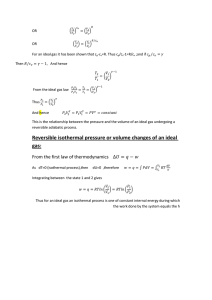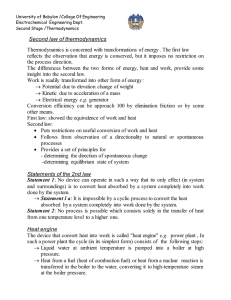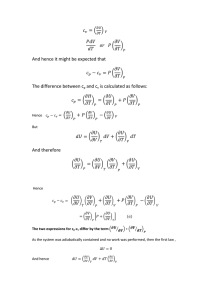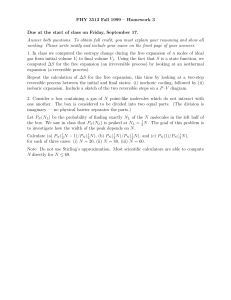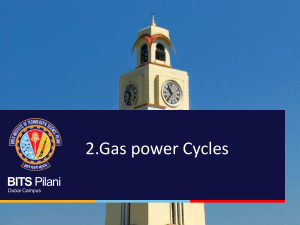University of Babylon /College Of Engineering Electrochemical Engineering Dept.
advertisement
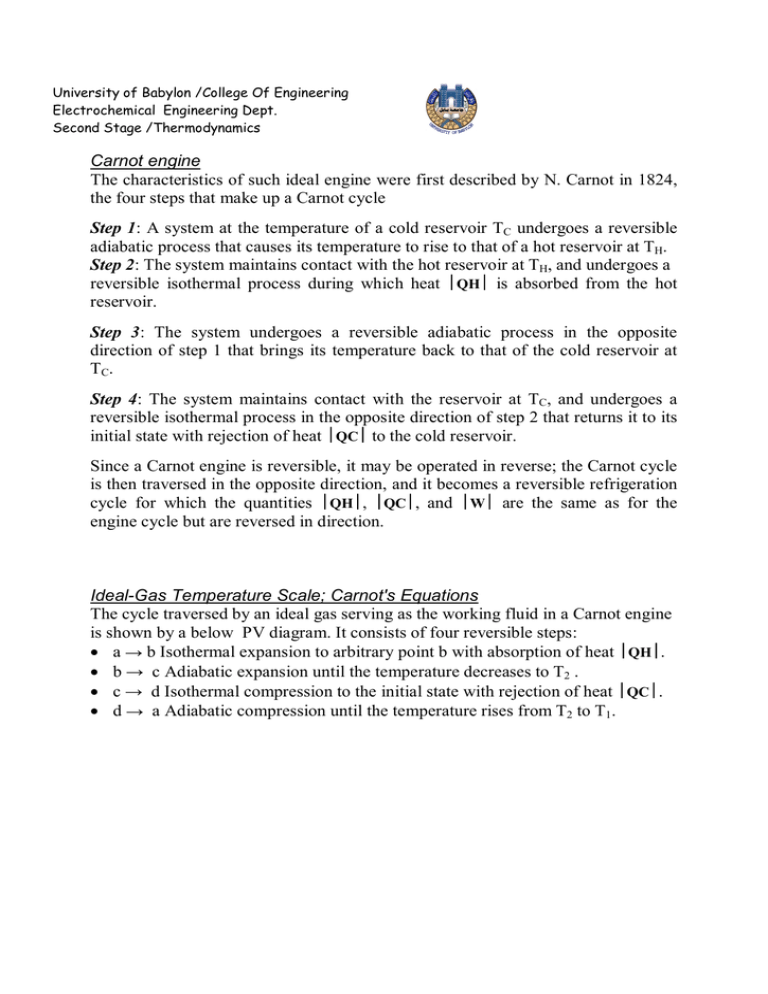
University of Babylon /College Of Engineering Electrochemical Engineering Dept. Second Stage /Thermodynamics Carnot engine The characteristics of such ideal engine were first described by N. Carnot in 1824, the four steps that make up a Carnot cycle Step 1: A system at the temperature of a cold reservoir TC undergoes a reversible adiabatic process that causes its temperature to rise to that of a hot reservoir at TH. Step 2: The system maintains contact with the hot reservoir at TH, and undergoes a reversible isothermal process during which heat ½ QH½ ½ is absorbed from the hot reservoir. Step 3: The system undergoes a reversible adiabatic process in the opposite direction of step 1 that brings its temperature back to that of the cold reservoir at TC. Step 4: The system maintains contact with the reservoir at TC, and undergoes a reversible isothermal process in the opposite direction of step 2 that returns it to its initial state with rejection of heat ½ QC½ ½ to the cold reservoir. Since a Carnot engine is reversible, it may be operated in reverse; the Carnot cycle is then traversed in the opposite direction, and it becomes a reversible refrigeration ½, ½QC½ ½, and ½ W½ ½ are the same as for the cycle for which the quantities ½ QH½ engine cycle but are reversed in direction. Ideal-Gas Temperature Scale; Carnot's Equations The cycle traversed by an ideal gas serving as the working fluid in a Carnot engine is shown by a below PV diagram. It consists of four reversible steps: · a → b Isothermal expansion to arbitrary point b with absorption of heat ½ QH½ ½. · b → c Adiabatic expansion until the temperature decreases to T2 . · c → d Isothermal compression to the initial state with rejection of heat ½ QC½ ½. · d → a Adiabatic compression until the temperature rises from T2 to T1. University of Babylon /College Of Engineering Electrochemical Engineering Dept. Second Stage /Thermodynamics Step 1 : DU = 0 and Q = W = RT 1 ln PA PB Step 2: Q = 0 and W = C V (T 2 - T 1 ) T 2 PC = ] Reversible adiabatic process T1 PB Step 3: DU = 0 and Q = W = RT 2 ln Step 4: Q = 0 and W = C V (T 1 - T 2 ) ( g -1) g PC PD æT Þ çç 1 èT2 g ö ( g -1) P B ÷÷ = PC ø University of Babylon /College Of Engineering Electrochemical Engineering Dept. Second Stage /Thermodynamics Reversible adiabatic process Eff . = Q1 - Q 2 = Q1 RT 1 ln T 2 PD = ] T1 PA ( g -1) g æT Þ çç 1 èT2 ö ÷÷ ø g ( g -1) = PA PD PA P - RT 2 ln D PB PC P RT 1 ln A PB PA P = D PB PC \h = T1 - T 2 T =1- 2 T1 T1 Where T1 and T2 in Kelvin scale This equation are known as Carnot`s equation .The thermal efficiency of a Carnot engine approaches unity only when TH (T1) approaches infinity , or TC (T2)approaches zero. Conclusions: · no engine operating between two heat reservoir each having a fixed temperature can be more efficient than a reversible one operate between the same temperature. · All reversible engine operation between two heat reservoirs at the same temperature , each having the same efficiency. · The efficiency of any reversible engine operate between two reservoirs is independent of the nature of the working but depend on the temperature of reservoirs.
